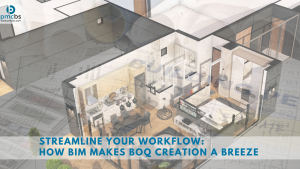Are you looking to revolutionize your construction projects? Dive into the world of Building Information Modeling (BIM), where every stage of the project lifecycle is optimized for success. In this guide, we’ll explore the BIM for Project Lifecycle management, its benefits in project management, and how it enhances project delivery from conception to completion.
Table of Contents
Understanding BIM for Project Lifecycle Management
Building Information Modeling (BIM) is a collaborative process that allows stakeholders to create and manage digital representations of physical and functional characteristics of a facility. It goes beyond traditional 2D drawings, providing a holistic view of the project from inception to operation.
BIM in Pre-Construction Planning
Visualizing Project Scope
BIM enables stakeholders to visualize and analyze project scope, identifying potential challenges and opportunities before construction begins. This proactive approach minimizes risks and ensures alignment among project stakeholders.
Cost Estimation and Budgeting
With BIM, project teams can generate accurate cost estimates and budget forecasts based on detailed 3D models. This enhances financial planning and enables better decision-making throughout the project lifecycle.
Design Optimization with BIM
Iterative Design Process
BIM facilitates an iterative design process, allowing architects and engineers to explore multiple design alternatives and evaluate their impact on performance, cost, and sustainability. This iterative approach leads to optimized design solutions that meet project objectives.
Clash Detection and Coordination
BIM software enables clash detection and coordination among different building systems, such as mechanical, electrical, and plumbing (MEP). This early clash resolution minimizes design conflicts and reduces costly rework during construction.
Collaboration and Coordination in Construction
Seamless Communication
BIM fosters seamless communication and collaboration among project stakeholders by providing a centralized platform for sharing information, coordinating activities, and resolving issues in real time. This enhances transparency and accountability throughout the construction process.
Integrated Project Delivery (IPD)
BIM supports Integrated Project Delivery (IPD), a collaborative approach that involves all stakeholders from the outset of the project. This integrated approach fosters teamwork, innovation, and shared risk and reward, leading to improved project outcomes.
Construction Management with BIM
Schedule Optimization
BIM enables schedule optimization by simulating construction sequences and identifying potential bottlenecks before they occur. This proactive approach minimizes delays and ensures projects are completed on time and within budget.
Quality Control and Safety
BIM facilitates quality control and safety by providing real-time insights into construction progress and identifying potential issues that may impact quality or safety. This proactive approach minimizes rework and enhances worker safety on site.
BIM for Facility Management
As-Built Documentation
BIM provides as-built documentation that accurately reflects the final condition of the facility, including all changes and modifications made during construction. This comprehensive documentation serves as a valuable resource for facility managers during operation and maintenance.
Predictive Maintenance
With BIM, facility managers can implement predictive maintenance programs based on real-time data collected from sensors and IoT devices embedded within the facility. This proactive approach minimizes downtime and extends the lifespan of building systems and equipment.
Harnessing BIM for Project Delivery
Improved Project Delivery
By leveraging BIM throughout the project lifecycle, organizations can achieve improved project delivery with better cost control, schedule adherence, and quality outcomes. BIM enables teams to collaborate more effectively, make informed decisions, and deliver projects that exceed client expectations.
Client Satisfaction
BIM enhances client satisfaction by providing greater transparency, accountability, and predictability throughout the project lifecycle. Clients can visualize project progress, provide feedback in real time, and make informed decisions that align with their goals and objectives.
Overcoming Challenges in BIM Implementation
Cultural Resistance
One of the key challenges in BIM implementation is cultural resistance within organizations. Overcoming this challenge requires leadership commitment, training, and change management strategies to foster a culture of innovation and collaboration.
Technology Adoption
Another challenge is technology adoption, as organizations may lack the expertise or resources needed to implement and utilize BIM effectively. Investing in training and education programs can bridge this gap and empower staff with the skills needed for success.
Implementing BIM in Your Projects
Define Clear Objectives
Start by defining clear objectives and goals for BIM implementation in your projects. Identify key stakeholders, establish roles and responsibilities, and develop a roadmap for adoption and integration.
Invest in Training and Education
Invest in training and education programs to empower your team with the skills needed to succeed in BIM implementation. Provide ongoing support and resources to ensure continued learning and development.
FAQs: Answering Your Burning Questions
1. How does BIM enhance project delivery?
BIM enhances project delivery by facilitating collaboration, improving communication, and enabling better decision-making throughout the project lifecycle. It helps teams optimize design, construction, and facility management processes, leading to improved outcomes and client satisfaction.
2. What are the key benefits of BIM in project management?
The key benefits of BIM in project lifecycle management include improved visualization, enhanced coordination, better cost control, schedule optimization, and quality assurance. BIM enables stakeholders to make informed decisions, mitigate risks, and deliver projects more efficiently.
3. How can BIM improve project scheduling?
BIM improves project scheduling by simulating construction sequences, identifying potential conflicts, and optimizing resource allocation. This proactive approach minimizes delays and ensures projects are completed on time and within budget.
4. What challenges should organizations anticipate when implementing BIM?
Organizations may encounter challenges such as cultural resistance, technology adoption, skill gaps, and interoperability issues when implementing BIM. Overcoming these challenges requires leadership commitment, training, and collaboration among stakeholders.
5. What steps can organizations take to successfully implement BIM in their projects?
To successfully implement BIM, organizations should define clear objectives, invest in training and education, establish standardized processes and protocols, foster a culture of collaboration, and leverage external expertise and support as needed. Regular evaluation and adaptation are key to success in BIM implementation.





